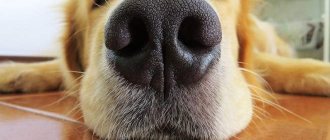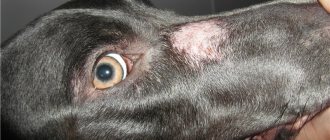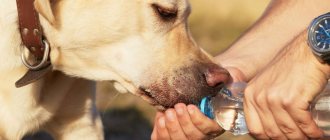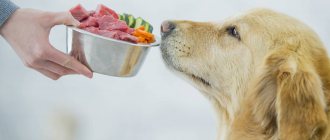Cracked noses in dogs can be caused by a variety of causes, most of which are treatable. Whether your dog gets too close to the heater during the winter months or has allergies, cracked noses are a cause for concern due to discomfort. If your dog has a cracked nose, it is a good idea to monitor him for other signs that indicate he may be in pain. Your veterinarian will likely have the definitive answer regarding your dog's cracked nose and should be consulted.
Why does my dog have a dry and hot nose?
Most pet owners say that dry mucous membranes indicate that the dog is not feeling well. Most likely, he is unwell and in poor condition. In fact, this is not true; you cannot judge a dog’s health just by the condition of its nose.
Why does a dog have a dry and hot nose:
- High temperature outside
- Dog mobility, playing and running outside
- Lack of water
- Individual structural features of the dog
Treatment
In case of injury. It is necessary to stop the bleeding. Identify the cause and location of the injury and disinfect the area. If necessary, administer anesthetic and apply stitches. Take medication that will promote further healing. Preparations: Lysozyme, Travmatin, Ranosan, etc.
When dehydrated. Force drink water using a syringe. Apply a dropper with glucose solution. If necessary, then medications.
For allergies. If you have a food allergy, then choose a diet that excludes those foods that cause an allergic reaction. If you are allergic to fleas, use collars and special shampoos. With Atopic allergies, the animal cannot be cured, but with the use of certain medications, vital signs can be improved. Medicines: Antihistamines.
With vitamin deficiency. Review and recalculate the animal’s diet, balancing it.
In case of poisoning. It is possible to wash the gastrointestinal tract with potassium permanganate. Preparations: vitamin B6, adsorbents.
For helminths. Anthelmintics.
For colds. Depending on the type of cold, take certain medications. Medicines: antibiotics, vitamins, immunostimulants, anti-inflammatory and expectorants.
Pet owners should understand that self-medicating their pet is very dangerous, this can lead to a deterioration in its condition, or, in the worst case, death.
Why does a dog have a dry nose? Reasons
Accordingly, in order to find out whether a dog is sick with something or not, it is necessary not only to evaluate the dryness of the tip of the muzzle, but also how he feels in general, there are no suspicious symptoms. If a pet suffers from vomiting, is restless, does not eat well, but its mucous membranes are wet, this is a sign of a disease, so you should not focus only on the moisture content of the tip of the muzzle.
Why does a dog have a dry nose, reasons:
- Oddly enough, our pets can suffer from allergies, just like people. Accordingly, in early spring, when plants are just beginning to bloom, the dog may experience dry mucous membranes. There may not be any additional symptoms.
- Most often, it is precisely because a wet nose attracts all sorts of allergens that it becomes dry to maintain health. It is necessary to pay attention to the weather, not only hot, but also cold. In frosty times, when there is a strong squall wind, the pet’s mucous membranes are dry and warm. This is due to the fact that a wet nose can become covered with an icy crust; therefore, the drying of the secretion in such conditions is a natural phenomenon in order to protect the dog from various ailments.
- Allergies in dogs can be caused not only by plant pollen, but also by some objects used in the feeding process. These can be bowls, as well as rodents made from low-quality silicone or plastic. Both people and dogs can be allergic to cheap Chinese plastic.
Cutie
Options for solving the problem
Treatment for this condition should be targeted, directly related to the cause that caused cracks in the nose. Therefore, treatment at home can not only be pointless, but also dangerous for the animal. First of all, you need to identify the cause of the disease, and based on this, the doctor will prescribe medications and procedures.
The dry surface of the nose can be lubricated with Trivit - a vitamin solution, ointments as prescribed by a veterinarian. It is necessary to exclude the possibility of injury and rubbing of this area with a muzzle, which can only aggravate the condition. In addition, the animal must be provided with peace of mind, clean conditions, a balanced diet and adhere to the full course of treatment prescribed by the veterinarian.
What does it mean if a dog has a dry nose?
If the pet is cheerful, feels good, does not refuse food and walks, and is generally playful and happy, then dry mucous membranes should not cause fear, doubt or worry. Most likely, everything is fine with your pet. Typically, the mucous membrane dries out in most dogs in hot weather, when it is very hot, there is not enough moisture.
Nowadays this happens mainly in dogs that are kept outside, and sometimes they forget to add water. Often it is the lack of water that causes dry mucous membranes. This indicates that the dog is in the early stages of dehydration, which is why the mucous membranes are drying out. What does it mean if a dog has a dry nose? In hot weather, if your dog has a dry nose, be sure to provide an additional container of water.
Cute pet
Associated symptoms
If additional symptoms appear, it is better to show your pet to a veterinarian. It is very difficult to make a diagnosis on your own, since most diseases have a similar clinical picture.
Lethargy
The dog does not respond to commands, refuses to play and does not leave the bed. A lethargic state is the first alarm bell, signaling illness, along with poor appetite.
Lack of appetite
Loss of appetite is characteristic of elevated temperature. Due to weakness, the body does not have the strength to digest foods; reduced activity reduces the need for calories. Additionally, there may be an increased or decreased interest in water.
Read also: Why antibiotics don't help
Increase or decrease in temperature
A rise in temperature above 39.3°C or a drop below 37.3°C is characteristic of poisoning, parasitosis, hypothermia or internal bleeding. Be sure to show your pet to a doctor if his condition does not improve within 24 hours.
Rapid breathing
If the dog breathes heavily and frequently at rest, then the cause of shortness of breath lies in pathology. Breathing disorders are typical for heat strokes, allergies, pulmonary parasitosis, injuries, infections and poisonings.
Salivation
This symptom is one of the signs of rabies. An infected pet can infect others through saliva, so contact a veterinary clinic and prevent any contact until doctors arrive.
Runny nose, cough
Similar symptoms always accompany a cold. Due to congestion in the nasal sinuses, your four-legged pet may snore in his sleep. The condition is complicated by the appearance of wheezing and can develop into pneumonia.
Severe itching
An attack of scabies occurs upon contact with allergens and after infection with parasites. If an animal suffers from constipation, vomiting, swelling and peeling of the skin, then it will have to undergo diagnostics at a veterinary clinic.
Why does my dog have a cold and dry nose?
If a dog has been in a fight or has wounds or ulcers on its body, then dry mucous membranes are common. This means that the dog has experienced severe stress, he has some damage, so the body is trying to mobilize and not waste extra energy on moisturizing the mucous membrane. Please note that if your dog has a cold and dry nose, he most likely has the early stages of a cold. A little later, the dog may start coughing and sneezing. In this case, it is necessary to give medications and provide good care, as well as proper feeding.
If the dog lives in an apartment, then dry mucous membranes can be observed if the heating radiators are heated in the house, and the humidity level is very low. If your home has air conditioning, or it's the heating season, it's time to buy a humidifier. This will be useful not only for the residents of the house, people, but also for pets, including cats and dogs.
The dog is sick
What should the owner do?
If you find that your pet's nose is warm and dry, don't panic. Monitor the dog’s behavior – does it have an appetite, is it active. If the dog behaves normally, he is healthy, and the dryness will soon go away. If his nose remains warm for a long time and his health worsens, measure his body temperature. If the temperature is above 38.5 degrees, take your pet to the veterinarian. If the temperature has exceeded 40 degrees, it should first be brought down, and only then go to the veterinarian.
If your pet has other signs of illness besides a dry nose, do not delay a visit to the clinic. The sooner you start treating your dog, the faster your pet’s condition will return to normal.
Why is my dog's nose wet and cracking?
Please note that in babies, that is, puppies, immediately after birth, the thermoregulation system has not yet been established, so they may have a dry nose. Over time, when the puppy grows up, everything will return to normal. Why do doggies usually have moist mucous membranes? This is due to the fact that the tip of the muzzle serves not only as a sense of smell, but also as a radar, which is used to navigate in space. This function is also performed by the mustache located at the tip of the muzzle.
Why does a dog's nose become wet and cracked?
- This is necessary to ensure good sensitivity and excellent spatial orientation. The top of the nose is wet because it is covered with special mucus, the composition of which is very similar to that of humans.
- In dogs, mucus spreads not only to the inside of the nose, but also to the outside. In addition, the tip of the nose contains a lot of nerve endings and blood vessels, the integrity of which is maintained by a moist environment and a special mucous secretion.
- Therefore, if a dog is deprived of this moisture, it may feel unwell and be less able to navigate in space. This carries some danger for the pet, since it loses its senses by about 50%.
- With the help of this important film, the air that enters the dog's respiratory tract is heated or further cooled depending on weather conditions.
Cheerful dog
In what cases should you immediately contact the clinic?
Throughout the entire article, we have repeatedly emphasized that you will still have to call a veterinarian to see your pet. But here are the cases in which you need to immediately contact the clinic:
- If the pet lies flat and does not react to anything at all.
- Refusal of water. A short-term (up to 12 hours) hunger strike is allowed, since it is not so dangerous for the puppy’s life.
- Apathy, strange behavior of the animal. These signs may indicate serious infections and central nervous system damage.
- Hoarse, heavy and intermittent breathing. This is how severe upper respiratory tract diseases manifest themselves.
Why does my dog have a dry nose and no appetite?
Some dogs, due to their individual characteristics of the body, may also be characterized by dry mucous membranes and its high temperature. However, in most cases, veterinarians sometimes recommend moisturizing the nose of such pets using special drops, as well as antibacterial compounds. If a dog has a dry nose and no appetite, it becomes vulnerable to various microorganisms and bacteria. Dogs with a dry nose are more likely to catch some kind of infection and get sick faster.
As you can see, it is necessary to monitor the dog’s condition, including the dryness of the nose, as well as its temperature. Very often, dry and mucous membranes become the first symptom of a serious illness. This should cause concern to the owner and increased interest in his four-legged friend.
Nature radar
Signs of pathology
If the reason why a dog's nose is cracking is pathological, then this is accompanied by the following symptoms:
- Increased dryness of the skin;
- Peeling;
- An increase or decrease in body temperature, as well as a local increase in temperature;
- Lack of appetite;
- Changes in the animal's behavior;
- Runny nose;
- The occurrence of regular scratching in the affected area;
- Vomiting, nausea;
- Problems with urination and bowel movements.
If the above signs are present, it is recommended to immediately show the animal to a doctor to identify the problem and prescribe timely treatment.











